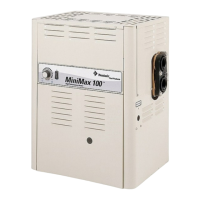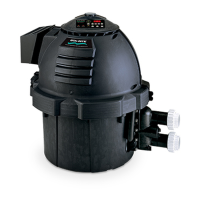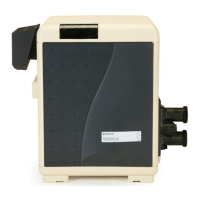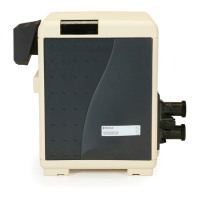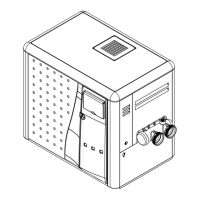ETi 250 High Efficiency Pool and Spa Heater Installation and User’s Guide
23
BELOW POOL INSTALLATION
If the heater is below water level, the pressure switch must be adjusted.
This adjustment must be done by a qualied service technician. See following CAUTION before installation.
CAUTION
BELOW OR ABOVE POOL INSTALLATION
The water pressure switch is set in the factory at 3.00 PSI (± 0.75 PSI). This setting is for a heater installed at pool level.
If the water pressure switch is more than 1 ft (30 cm) below or above the pool level, the water pressure switch must be
adjusted by a qualified service technician. Figure 5 on page 15.
FLOW SWITCH
If the water pressure switch is installed more than 3 ft (0.9 m) above the pool or more than 3 ft (0.9 m) below the pool
level, you will be beyond the limits of the pressure switch and a flow switch must be installed. Locate and install the
flow switch externally on the outlet piping from the heater, as close as possible to the heater. Connect the flow switch
wires in place of the water pressure switch wires.
Installation
GAS CONNECTIONS
GAS LINE INSTALLATIONS
Before installing the gas line, be sure to check which gas the heater has been designed to burn. This is important because
different types of gas require different gas pipe sizes. The rating plate on the heater will indicate which gas the heater
is designed to burn. Table 2 (Gas Pipe Sizing on next page), shows which size pipe is required for the distance from
the gas meter to the heater. The table description is for natural gas at a specic gravity of 0.60, and propane gas at a
specic gravity of 1.50.
When sizing gas lines, calculate three (3) additional feet of straight pipe for every elbow used. When installing the gas
line, avoid getting dirt, grease or other foreign material in the pipe as this may cause damage to the gas valve, which
may result in heater failure.
The gas meter should be checked to make sure that it will supply enough gas to the heater and any other appliances that
may be used on the same meter. The gas line from the meter will usually be of a larger size than the gas valve supplied
with the heater. Therefore a reduction of the connecting gas pipe will be necessary. Make this reduction as close to the
heater as possible.
The heater requires a gas supply of not less than 4 in (10,2 cm) wc, and not more than 10.5 in (27 cm) wc for natural
gas, and not more than 14 in (36 cm) wc for propane gas. Gas supply pressures outside of this range may result in
improper burner operation. A minimum owing or dynamic inlet pressure (while the heater is running) of 4 in (10,2 cm)
wc is required to maintain input rating with no more than a 2 in pressure drop between static and dynamic. The gas
supply must be installed in accordance with the National Fuel Gas Code, ANSIZ223.1, or standard CSA B149.1, Natural
Gas and Propane Installation Codes, as applicable and all applicable local codes. Install a manual shut-off valve and a
sediment trap and union located outside the heater panels, see Figure 16. Do not use a restrictive gas cock. The following
minimum gas pipe sizes are recommended for natural gas supply piping, see Table 2 on below. For low pressure Propane
gas, pipe size may be reduced by 1/4-in, with a minimum pipe size of 1/2-in. Check for compliance with local codes.
The heater and any other gas appliances must be disconnected from the gas supply piping system during any pressure
testing on that system, (greater than ½ PSI). The heater and its gas connection must be leak tested before placing the
heater in operation. Do not use ame to test the gas line. Use soapy water or another nonammable method.
NOTE: A manual main shut-off valve must be installed externally to the heater.
WARNING
DO NOT INSTALL THE GAS LINE UNION INSIDE THE HEATER CABINET. THIS WILL VOID YOUR WARRANTY.
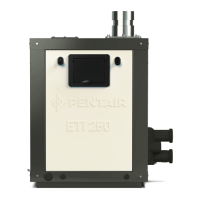
